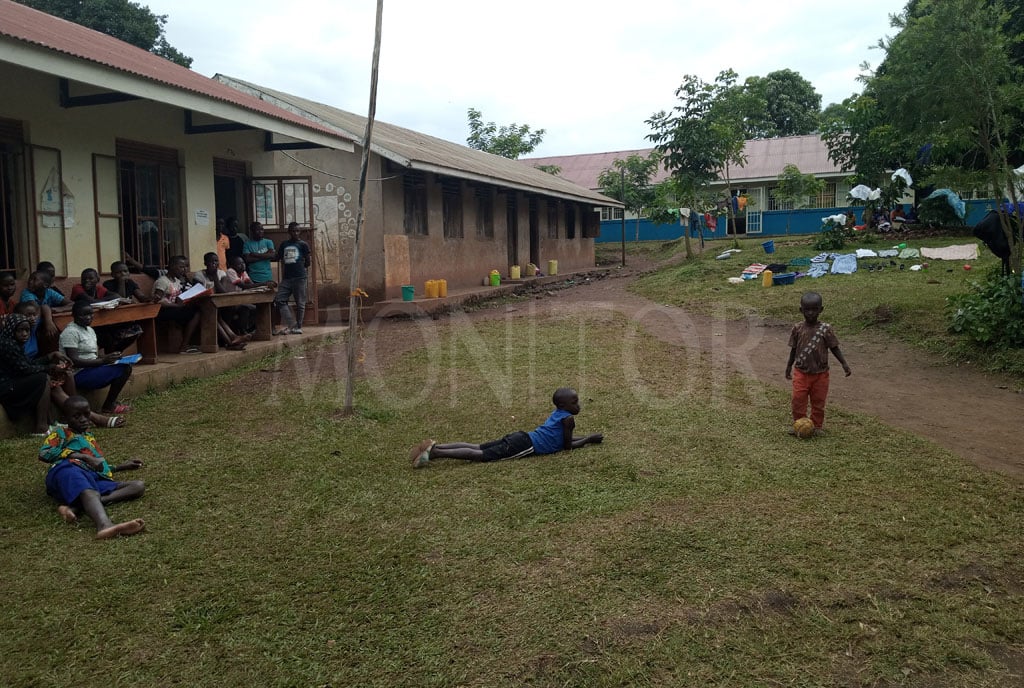Classrooms shortages hit Kamwenge schools

Some of the pupils seated outside a classroom block at Rwengobe Primary School in Kamwenge District on Thursday last week. PHOTO/ALEX ASHABA
What you need to know:
- Lower primary classes; P1 to P3, are taught in the morning while upper classes report in the afternoon.
Most of the government-aided schools in Kamwenge District are short on infrastructure, mainly classrooms, leading to congestion due to overwhelming number of learners.
The hardest-hit schools include Rwamwanja, St Michael, Kyempango and Nteziryayo, some of which have started conducting double class shifts.
Rwamwanja primary school head teacher Lawrence Twazamace said the school has 16 out of 58 classrooms required to accommodate 3,044 learners.
“We got new classroom blocks recently, but we still have shortage of classrooms … we decided to start conducting our classes in double shifts because [all] learners cannot be accommodated in our classrooms at once,” he said.
Lower primary classes; P1 to P3, are taught in the morning while upper classes report in the afternoon.
ALSO READ: A school without desks, latrines
The pupil enrolment at the school nearly tripled from the 1,263 pre-Covid numbers to 3,044 when the government reopened schools on January 10, this year, after nearly a two-year closure.
According to Kyempango primary school head teacher, Mr Lawrence Mutabazi, they have about 2,500 pupils studying in only 19 classrooms.
To ease the congestion problem, the school has resorted conducting double teaching shifts.
ALSO READ: Shortage of teachers hits schools
At Bigodi SS, which is government-aided, head teacher Herbert Nzana said that an increase of student numbers to 345 has outstripped available infrastructure.
CARFRED, a community organisation, founded the school in1993. The government took over the institution in 2016, but it is yet to bankroll construction of more classrooms.
“We are happy that we have received these new classroom blocks. It will help our students to learn under the conducive environment, but will still need more,” he said.
Mr Charles Tidyebwa, the vice chairman of the school’s board of governors, said Ministry of Education on a recent assessment of the institution recommended replacement of the semi-permanent structures with new permanent buildings.
The District Education Officer, Mr Apollo Mulinde, said they are aware of the problem, and he appealed to well-wishers to help build more school structures, including classrooms and staff accommodation.
“Most of the schools don’t have enough classrooms, but are still relying on DRDIP (Development Response to Displacement Impact Response) to continue building for us more classrooms,” he said.
Donation
MTN Foundation, in partnership with Peas, last week handed over three classrooms to Bigodi SS and a staff house to Rwengobe Primary School administrations to reduce the crowding.
The three classrooms at Bigodi SS are to absorb 180 students while the staff house is to accommodate seven teachers, and construction of the structures cost Shs350m.
Mr Wim Vanhelleputte, the MTN Uganda chief executive officer, said they are fulfilling the commitment to the people of Uganda to continually support and contribute towards the socio-economic wellbeing and development of the country.



